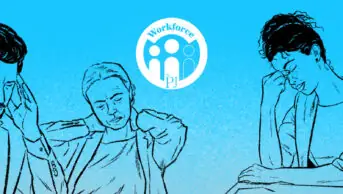
Simon Leigh / Alamy Stock Photo
Just 2.6% of pharmacists say that their place of work always has safe staffing levels, according to a survey carried out by the Pharmacists’ Defence Association (PDA).
The figure is a notable drop compared to 2020, when 8.4% of survey respondents said their place of work was always safely staffed.
Respondents to the ‘2021 Safer Pharmacies Survey’ were asked to rate their workplace experience against the seven commitments contained in the PDA’s ‘Safer Pharmacies Charter‘, which includes adequate rest, safe staffing levels and no self-checking. There were 1,337 respondents to the survey.
In other findings, almost one in five (19%) respondents said they were never able to take adequate rest at work, up from 11.7% in 2020. Just over a quarter (26.3%) said adequate rest was available to them “a minority of the time”, and just over one in ten (11.5%) said sufficient rest was always available.
The percentage of respondents who said their workplace never had safe staffing levels rose to 14.1% in 2021 — a big increase on the 5.6% reported in 2020.
There was also a reported increase in the number of people self-checking. In 2020, around one in five (22.2%) of respondents said they were never required to self-check, but in 2021 this had dropped to 14.3%.
Just one in five (19.8%) of respondents said they felt “physically safe” at work all the time — down from 27.4% in 2020.
The PDA’s findings echo those of The Pharmaceutical Journal’s 2021 salary survey, in which (73%) of respondents said that ‘staff absence’ was a factor in workplace stress and 78% of respondents said that lack of staff was a barrier to them doing their job effectively.
The journal’s survey also found that one in six (14%) pharmacists never took their contracted breaks, with a further 28% taking breaks infrequently.
In a statement published alongside the PDA’s survey results, it said that the findings “need to be urgently addressed in the interest of pharmacists’ health and wellbeing, and the impact that less than ideal working environments may have on patient care”.
“Issues of recruitment and retention in the community pharmacy sector also need to be addressed as some employers seem to find it difficult to accept that many pharmacists, given a choice, would rather work elsewhere,” the statement added.
Paul Day, director of the PDA, said: “[The fact that] more than 97% of respondents to our survey have experienced unsafe staffing levels in the last 12 months is truly shocking.
“We understand that the subsequent damage done to the reputation of pharmacy by those employers who’ve made unsustainable cuts means that it has also impacted the attitude of many pharmacists to working in pharmacy at all,” he added.
“Many pharmacy businesses, including those who have tried to maintain safe staffing levels, are therefore experiencing recruitment difficulties as a consequence of the actions of those who have chosen to cut safe staffing.”
Read more: Work-related stress: the hidden pandemic in pharmacy


